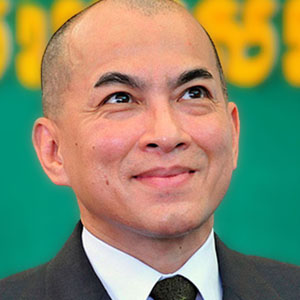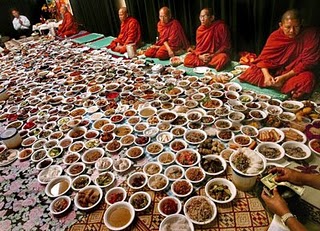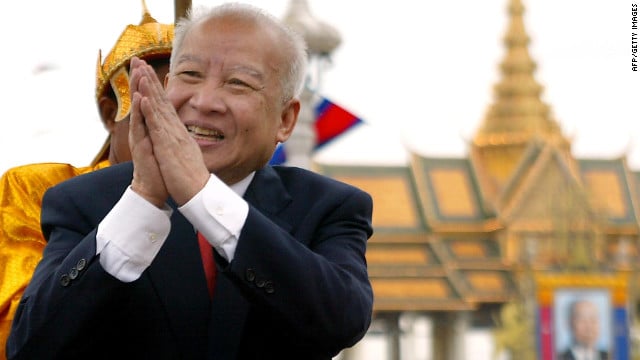New Year’s Day.
January 1. The traditional
New Year’s Day on January 1 is relatively passed over. Businesses and schools
are closed on this day, but that’s pretty much it. The big celebration happens
at the Khmer New Year in April.
Victory Day.
January 7. This day celebrates the end of the Khmer Rouge regime in 1979
(the year I was born). On this day, Vietnamese troops entered Cambodia and
started a bloody clash that ended the reign. Most estimates report around two million Cambodians were
killed in the genocide. Even after all these years, it’s still an emotional
holiday and viewed with mixed feelings since it led to a dependency upon
Vietnam afterwards. Speeches from
government officials and memorial services are often held on this day, as well
as other displays of Cambodian cultural arts.
Meak Bochea.
Varies. It’s a movable
Buddhist holiday, mostly taking place during February. The holiday was
established for the spontaneous gathering of monks to listen to the Buddha’s
preaching. However, on this particular day, the Buddha accurately predicted his
own death three months later. The
main ceremony is held in the Kandal province. Three hundred Buddhist monks are
invited to the ceremony and offered money, food and drink. Other Buddhist
countries celebrate this holiday annually as well.
International Women’s Day. March 8. We just celebrated this holiday a few days ago
(which I celebrated by doing things that I “wanted”: going to work, picking up
Chinese take-out, and buying a cherry pie. And some Stella Artois.). It’s a
holiday celebrating women, out struggles, and how far we’ve come in the world
towards equality. One extraordinary Cambodian woman I discovered is Somaly Mam,
who continues to fight for getting girls out of the sex trade. I’ll write more
on her when I get to literature.
Khmer New Year.
April 14-16. This is the
largest and most important holiday in Cambodia. It’s set around the time of year to celebrate the end of the
harvest. Many people head to the
temples to receive blessings from the monks. While on the temple grounds,
people will build five sand hills representing nirvana and decorate them with
religious flags. The holiday lasts three days. On the first day, people clean
and lighten their homes, decorating them with candles, flowers, statues of
Buddha, as well as making a lot of food (much of which will be donated to the
monks at the local temple). On the second day, people will often give to
charity and help the poor. The third day is about washing: people will douse
their own statues of Buddha with scented water, the children will wash their
elder’s feet in return for blessings, and monks will perform a ceremony washing
of the Buddha statues at the temple. Games are also popular at this time and
each day a type of game is played.
Visaka Bochea.
Varies. This day is in
honor of the passing away of the Buddha 2557 years ago, as predicted on Meak
Bochea. On this day, people often listen to talks about the Buddha’s teachings,
and especially regarding The Noble Eightfold Path, the eight ways for getting
rid of suffering.
Labor Day. May
1. This day is for discussing labor issues and celebrating the worker. Usually
there are a lot of speeches and parades. It’s also a common time to discuss
labor disputes, minimum wage, and the state of jobs in the country.
Royal Ploughing Ceremony. Varies. This holiday marks the beginning of the rice
cultivation season. Its roots stem from Hinduism, and the ceremonies are headed
by the royal family. These
ceremonies are also a way to predict how well the crops will turn out that
year, sort of like Groundhog Day in the US predicts how close to spring we
are.
King Sihamoni’s Birthday. May 13-15. This day is in honor of HM Norodom Sihamoni’s
birthday. His birthday is actually on May 14, but the holiday starts the day
before and the day after. Before
he was king, he was a ballet instructor and cultural ambassador in Europe. People decorate their homes with
colorful lights, portraits of the king and national flags.
Queen Mother’s Birthday. June 18. This day is in honor of the mother of the current
King Sihamoni and the wife of Norodom Sihanouk, Norodom Monineath. Born in
Saigon, Vietnam, she married into the royal family of Cambodia and became the
president of the Cambodian Red Cross. In honor of her birthday, the a large
portrait of her is placed in front of the palace, and certain radio and
television programs will often have a short program about her life and
accomplishments.
Constitution Day.
September 24. This marks the day in 1993 when Cambodia became a
constitutional monarchy. It also marks the day when King Sihanouk retook over
the throne since after he was ousted in a coup by the Khmer Rouge.
Pchum Ben Festival.
Varies. Usually in October,
this 15-day festival is fairly unique to Cambodia. Also known as Ancestor’s
Day, people pay their respects to their deceased family members up to seven
generations (sorry eighth on back). At this time, people visit the temples and
give gifts of food to the monks. There’s also a tradition to throw rice into
the fields in order to feed the spirits. No word on whether they actually eat
it or not. Unless they were reincarnated as birds, perhaps.
King Father’s Birthday. October 31. This is in honor of the King Father’s birthday,
Norodom Sihanouk. He was the king from 1941 to 1955 and again from 1993 until
he abdicated the throne to his son in 2004. Last year, he celebrated his 90th
birthday (along with my grandmother). A large portrait of the king is placed in
front of the palace and many people will gather and have their pictures taken
in front of it. His birthday is only three days after mine.
Independence Day.
November 9. This year will mark the 60th year since declaring
independence from France. The king greets various government officials and
gives a speech to the people; there are parades and celebrations held throughout
Phnom Penh and across the country. People line the streets with portraits of
their king. Cities decorate itself with the national flags and the national
colors.
Water Festival/Boat Racing Festival. Varies. The largest of the boat races
are held in Phnom Penh, but other races are held in other cities, such as Siem
Reap. Traditionally, this was the method the king used to determine who were
the strongest warriors by choosing from the highest-placed finishers. The
festival itself lasts three days, making it one of the more popular festivals
in Cambodia.
Human Right’s Day.
December 10. This is a holiday in commemoration of the UN’s adoption of
the declaration of universal human rights in 1948. Celebrations are held all
over the world, and a very large celebration took place in 2008 in Phnom Penh
and around Cambodia with a massive parade of 5000 people, and 1000 people let
off balloons. I bet that was something to see.
Up next: art and literature










No comments:
Post a Comment